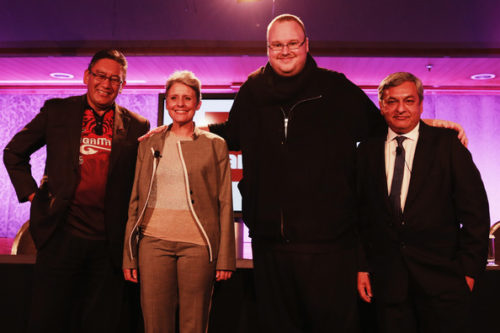
As the Maori Party split away from Labour, so did the MANA Party split away from the Maori Party, and then it joined up with Kim Dotcom’s Internet Party to become the Internet MANA chimera. But who did Hone Harawira’s machine end up appealing to?
Like the Maori Party, Internet MANA appealed to Maoris. The correlations between voting Internet MANA in 2014 and with both voting Maori Party in 2014 and being Maori were 0.84.
Correspondingly, there are strong correlations between voting Internet MANA in 2014 and voting for all of the Maori-heavy parties in 2014. Between voting Internet MANA in 2014 and voting Aotearoa Legalise Cannabis Party in 2014 the correlation was 0.76; with voting New Zealand First in 2014 it was 0.44; and with voting Labour in 2014 it was 0.41.
Curiously, Internet MANA voters were exactly as unlikely to have sympathies for National or Conservative as Maori Party voters. As with the Maori Party, the correlation between voting Internet MANA in 2014 and voting National in 2014 was -0.75, and the correlation with voting Conservative in 2014 was -0.64.
Perhaps the major demographic difference between Maori Party voters and Internet MANA ones is that the latter were slightly less Maori and slightly more Pacific Islander and Asian. The correlation between voting Internet MANA in 2014 and being a Pacific Islander was 0.07, and with being Asian it was -0.23 (compared to 0.01 and -0.30 for the correlations between these two groups and voting Maori Party).
In fact, the general demographic trend is that Internet MANA voters, despite being generally disenfranchised, are doing slightly better than Maori Party voters. Correspondingly, the correlation between voting Internet MANA in 2014 and turnout rate in 2014 was, at -0.69, slightly weaker than for the Maori Party (-0.74).
Although most of the demographic distinctions are subtle, one of the clearest is when it comes to education. The correlation between voting Internet MANA in 2014 and having no qualifications was 0.42, which was weaker than the equivalent for the Maori Party. Also, unlike with voting for the Maori Party in 2014, voting for Internet MANA in 2014 had no significant negative correlation with holding either of the two highest academic qualifications.
Further underlining the minor class differences, Internet MANA voters were marginally less likely to be on the unemployment or invalid’s benefits, and marginally more likely to be on the student allowance. Also, they were much less likely to work in manufacturing and slightly less likely to be regular tobacco smokers than Maori Party voters.
They were, however, essentially the same age. The correlation between voting Internet MANA in 2014 and median age was -0.65, making them the smallest smidgen older than Maori Party voters. This underlines the degree to which Internet MANA differentiates itself from the Maori Party primarily through subtle class differences and not age.
Curiously, Internet MANA voters were more likely to be self-employed than Maori Party voters, but were less likely to be self-employed with employees. This might reflect the degree to which Internet MANA voters, or at least a significant cadre of them, are more likely to be immigrants and therefore less likely to be established than Maoris.
It may be that, in so far as Internet MANA appeals to a newer sort of New Zealander, it also appeals to a sort of person who does not have the intergenerational poverty and trauma that many Maoris suffer from. This may explain the small differences in wealth, health and educational outcomes.
*
This article is an excerpt from Understanding New Zealand, by Dan McGlashan, published by VJM Publishing in the winter of 2017.
